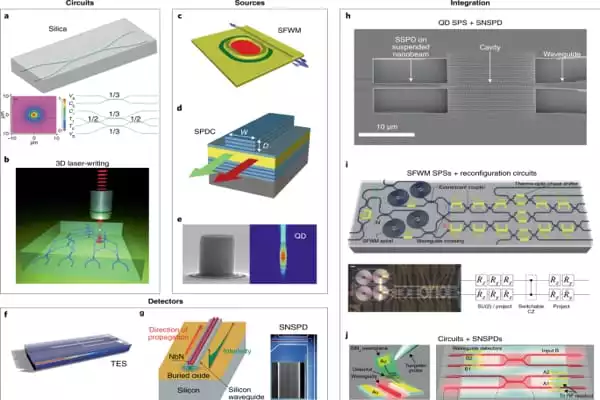Quantum technologies are a new class of devices that can regulate the superposition and entanglement of quantum states of light or matter in order to achieve fundamental performance benefits over traditional classical machines. The technology of integrated quantum photonics has enabled the generation, processing, and detection of quantum states of light at a steadily increasing scale and level of complexity, progressing from few-component circuitry with centimeter-scale footprints and operating on two photons to programmable devices with millimeter-scale footprints and integrated generation of multiphoton states.
An international team of top scientists has developed a detailed review of integrated photonics’ potential, global outlook, background, and frontiers. The study presents a road map for quantum integrated photonic circuits. The review addresses underlying technology, the current status of research, and potential future applications.
A worldwide team of top scientists, led by Paderborn physicist Professor Klaus Jöns, has developed a detailed review of the potential, global outlook, background, and frontiers of integrated photonics. The research, titled “A Roadmap for Integrated Photonic Circuits for Quantum Technologies,” has recently been published in the journal Nature Reviews Physics. The overview covers underlying technology, summarizes the current level of research, and describes potential future applications.
The integrated photonic platforms, which need a wide range of materials, component designs, and integration methodologies, present a number of obstacles, particularly signal losses, which are difficult to correct for in the quantum world.
Professor Klaus Jöns
“Over the previous two decades, photonic quantum technologies have attained a number of significant milestones. However, when it comes to converting lab discoveries to everyday applications, scalability remains a key difficulty. Applications frequently necessitate the use of over 1,000 optical components, each of which must be individually optimized. Photonic quantum technologies, on the other hand, can benefit from parallel advances in classical photonic integration “Jöns says. More research is needed, according to the scientists.
“The integrated photonic platforms, which need a wide range of materials, component designs, and integration methodologies, present a number of obstacles, particularly signal losses, which are difficult to correct for in the quantum world,” Jöns says. The authors argue in their study that the complicated innovation cycle for integrated photonic quantum technologies (IPQT) necessitates investments, the resolution of specific technological issues, the development of the required infrastructure, and further structuring toward a mature ecosystem. They conclude that there is a growing demand for scientists and engineers who are well-versed in quantum physics and its technological applications.

Photonic integrated circuits are used to regulate photonic quantum states for applications in quantum technologies in integrated quantum photonics. As a result, integrated quantum photonics offers a viable method for miniaturizing and scaling up optical quantum circuits. Quantum technology, including quantum computing, quantum communication, quantum simulation, quantum walking, and quantum metrology, is the primary application of integrated quantum photonics.
Integrated quantum photonics employs traditional integrated photonic technologies and devices for quantum applications, with chip-level integration important for scaling up and transferring laboratory demos to real-world solutions. Jöns elaborates: “Efforts in the field of integrated quantum photonics are diverse and involve the construction of quantum photonic circuits that can be monolithically, hybridically, or heterogeneously integrated. In our study, we explain what applications might be conceivable in the future if current hurdles are overcome.”
The scientists also give an overview of the research scene and evaluate the prospects for innovation and market growth. The goal is to promote additional research and investment by highlighting not only the scientific concerns but also the challenges associated with the creation of the requisite manufacturing infrastructure and supply chains for bringing the ideas to market.
Quantum photonics is the science of creating, controlling, and detecting light in regimes where individual quanta of the light field may be coherently controlled (photons). Historically, quantum photonics has been critical to understanding quantum phenomena, such as the EPR paradox and Bell test experiments. Quantum photonics is also predicted to play an important part in the advancement of future technologies including quantum computing, quantum key distribution, and quantum metrology. Because of their minimal decoherence, light-speed transmission, and ease of manipulation, photons are particularly appealing bearers of quantum information.
The experts believe that there is a pressing need to invest extensively in education in order to teach the next generation of IPQT engineers. Jöns says: “Regardless of the type of technology that will be employed in commercial quantum devices, the essential principles of quantum mechanics are the same. We anticipate an increase in demand for scientists and engineers who are well-versed in both quantum physics and its technological applications. Investing in the next generation’s education will help to push the scientific and technical frontiers.”















